AOpen AK86-L UPDATE: Uncommonly Good
by Wesley Fink on March 30, 2004 1:00 PM EST- Posted in
- Motherboards
AOpen AK86-L: Board Layout
The AK86-L is the all-black that AOpen has used on most of their recent top boards. The board itself is a bit smaller than full-size, requiring just 6 stand offs for installation.
Layout of the board is generally very good, although there are a few concessions to the smaller motherboard size. As mounted in a typical tower case, the CPU socket is in the upper center of the board, with all power connectors to the left of the CPU and DIMM slots to the right.
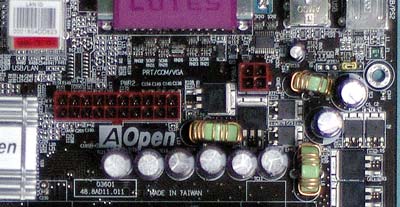
The Athlon 64 and FX51 boards use a standardized ATX plus 12V connector arrangement that is identical to the power connector requirements of current Pentium 4 systems. Generally, we prefer the connectors together on the upper right of the board, but AOpen has placed both the 20-pin ATX and 4-pin 12V together at the upper left of the board. This arrangement is acceptable in many cases, but it may require the bulky ATX cable to be routed around the CPU and this could interfere with CPU cooling in some case/power supply designs. We are more concerned that the large capacitors between the CPU socket and 20-pin ATX are in the way of releasing the 20-pin cable. It is hard to unlatch the 20-pin cable without pushing on the capacitors and risking damage. It is good to see AOpen use the large 3300µF capacitors for voltage stability, but more care needs to be paid to connector placement in relation to the large capacitors.
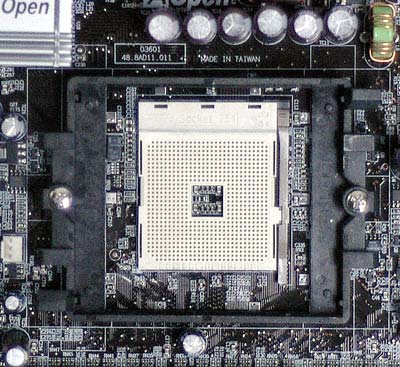
Despite all the tall capacitors around the CPU socket, we had no problem at all mounting the huge Zalman 7000 HSF or any other HSF that we had available. There is plenty of room around the CPU socket to mount most any cooler.
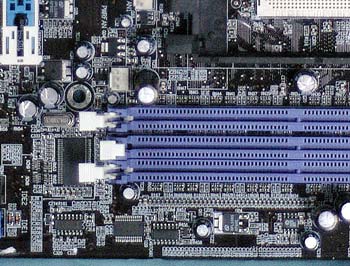
The DIMM slots are also clear and accessible, even when the largest CPU fan is installed. The DIMMs are well-spaced from the AGP slot, so there is no problem with the AGP card interfering with upgrading or changing memory.
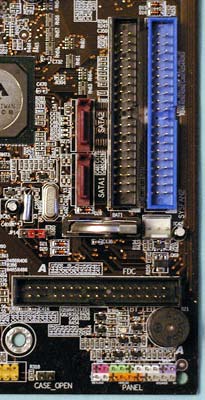
The Primary/Secondary IDE and floppy connectors are located on the lower right of the board. This will not be a problem in a standard mid-tower case, but it could be an issue in a full-tower case. We prefer an upper right location so that you don't have to worry about cable length in a full-tower case. Fortunately, all 3 connectors are on the right edge, so they do not interfere with other components on the board.
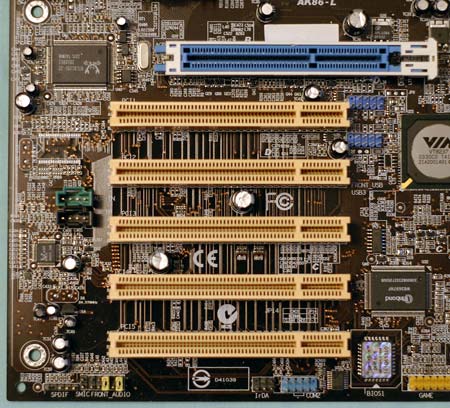
The AK86-L has 5 PCI slots and an 8X AGP slot that uses an easy-to-lock/unlock slide connector. The push-down connector on many AGP slots is hidden completely by high-end AGP cards, making release of a 9800 PRO or FX5900 more difficult than it needs to be. The slide lock used here is one of the easier-to-use arrangements that we have seen. The AGP slot is also protected by an LED at the end of the slot that will light if you install an unsupported video card using voltages higher than 1.5V.
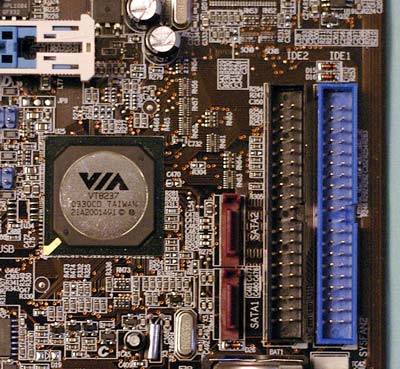
If you require a full-length PCI slot, you will have to use slot 4 or 5. SATA and IDE connectors will likely interfere with large PCI cards in slots 1-3.

AOpen and several other manufacturers are now using color-coded connectors for the case connections. The color coding and clearly marked polarity make it a little easier to get the connections right the first time.










22 Comments
View All Comments
Pumpkinierre - Monday, February 16, 2004 - link
In your update you say the new BIOS 1.06q includes cpu multipliers. But the old BIOS had that. So does this mean a larger range ie 0.5x divisions? Also now that you've got the Geiger, could you check the PCI lock at several clockspeeds?This is important to me as my interest in purchasing an a64 is to run it at high clockspeed (with only a mild o'clock) as I believe this would substanstially improve gaming performance. Of course this is also dependent on fast low latency DDR 466-500 being available- still yet to occur!.
Boonesmi - Thursday, February 12, 2004 - link
what about agp/pci lock? have you been able to test it yet??Wesley Fink - Thursday, February 12, 2004 - link
AOpen has just sent a revised BIOS 1.06Q, which adds vDimm adjustments from 2.5 to 3.0V in .05V increments. This is an outstanding upgrade from the 2.7v max vDimm in the BIOS we tested and makes the AK86-L one of the best 754 boards available for memory overclocking.A kind soul is hosting the 1.06q BIOS and a link has been added to the review.
JTDC - Tuesday, February 10, 2004 - link
Does anyone know where the 1.06 BIOS revision can be found? I cannot see it on the AOPEN site. Any suggestions as to where I can look?peonyu - Friday, February 6, 2004 - link
I have a Aopen board [not this one though,damn] and the options on it are awesome, same with its stability and performance. The only prob though is the same that this board has - VERY low voltage settings. For reasons i dont understand Aopen is very stubbern with allowing higher voltages, it happens with every board they release. So until they get past that and release a update which increases voltage I dont think it would be worth picking one of these up if your into overclocking.Shinei - Thursday, February 5, 2004 - link
Does Athlon 64 rely on timings as much as the Athlon XP did? I didn't think it did, considering the bandwidth it can use eclipses even the Pentium 4's...As for the article, now I really wish I'd waited a few months to upgrade, instead of going straight for the GA-7N400P2/2800+ in December...
Pumpkinierre - Thursday, February 5, 2004 - link
It would have been nice if you had included some benchmark results at the different multiplier o'clocks or even standardised to 2gig (ie 9x222,8x250) now that you have an A64 board that doesnt have memory, multiplier, HT or (from initial observations) AGP/PCI lock issues. Naturally memory latency settings would have to be kept the same. My pet theory with the A64 is that increasing the RAM speed and lowering memory latency (which appears difficult on many a64 mobo/memory combinations) would be as good as a standard o'clock which to date has'nt been the a64's strong point. This seems like the right board but we're still waiting for CAS2 DDR500.Boonesmi - Thursday, February 5, 2004 - link
dang i really like that board.when are you expecting the "PCI Geiger"??
hehe i want an update :)
Wesley Fink - Thursday, February 5, 2004 - link
#1 - Four "3-pin" fan headers is correct, and the typo is fixed.#2 - We will be reviewing a few of the memory brands you mention in a few weeks. A socket 754 board will be included in the tests.
bhtooefr - Thursday, February 5, 2004 - link
Damn, I want one! Of course, it would be even better if it were Micro ATX... (I've already got a mATX case, and it's very small)